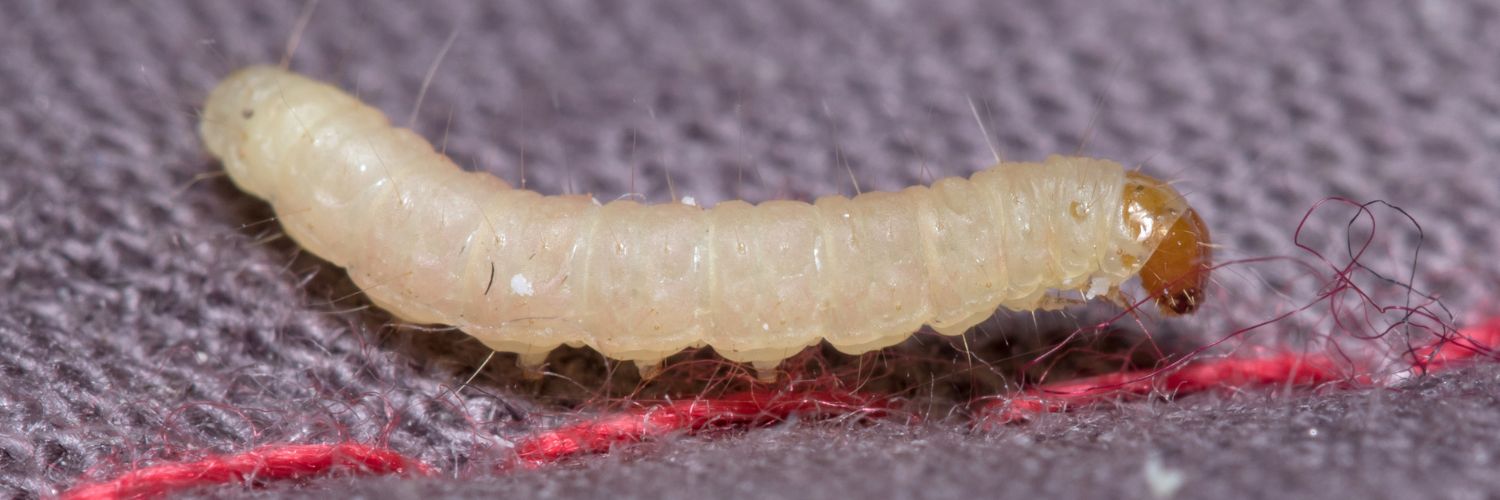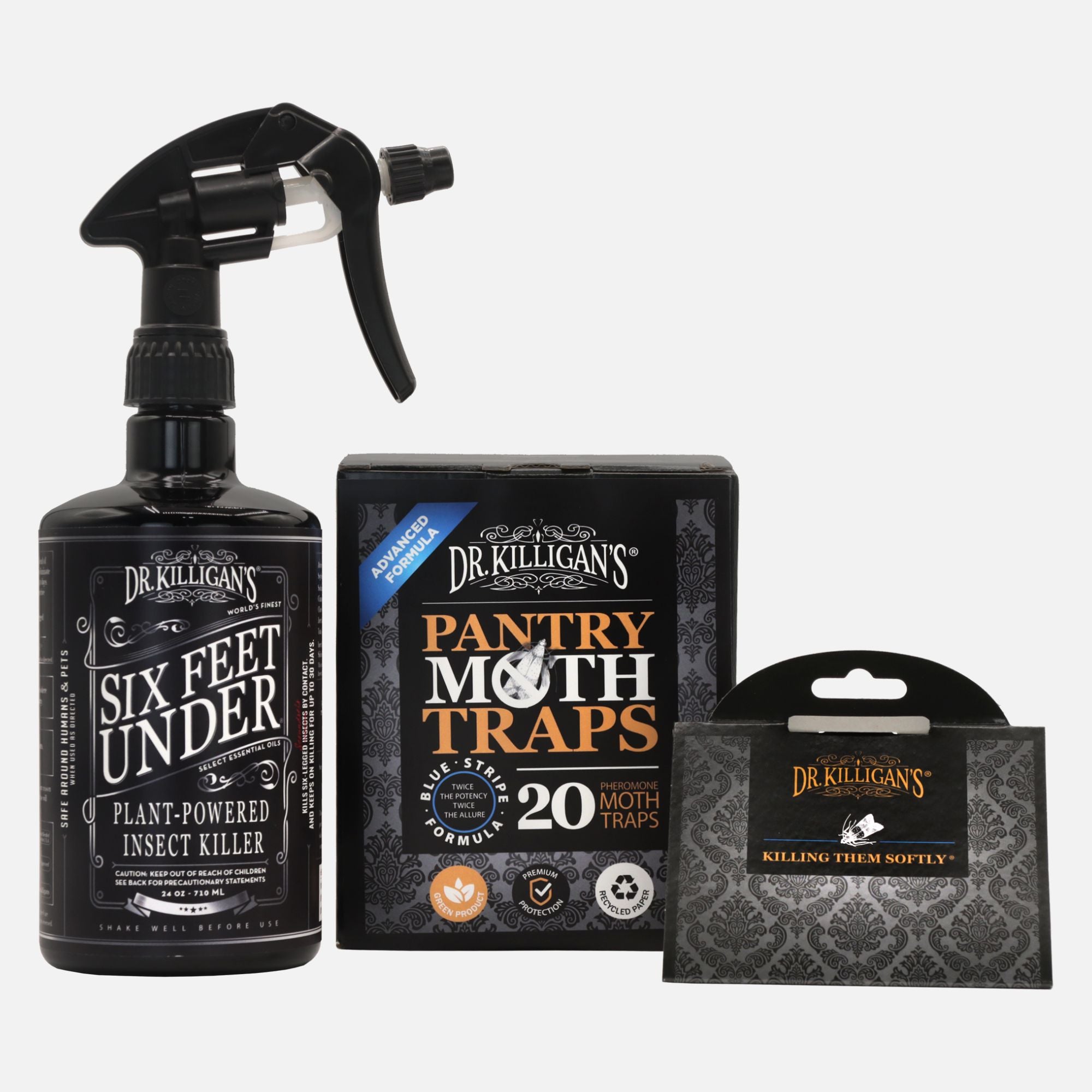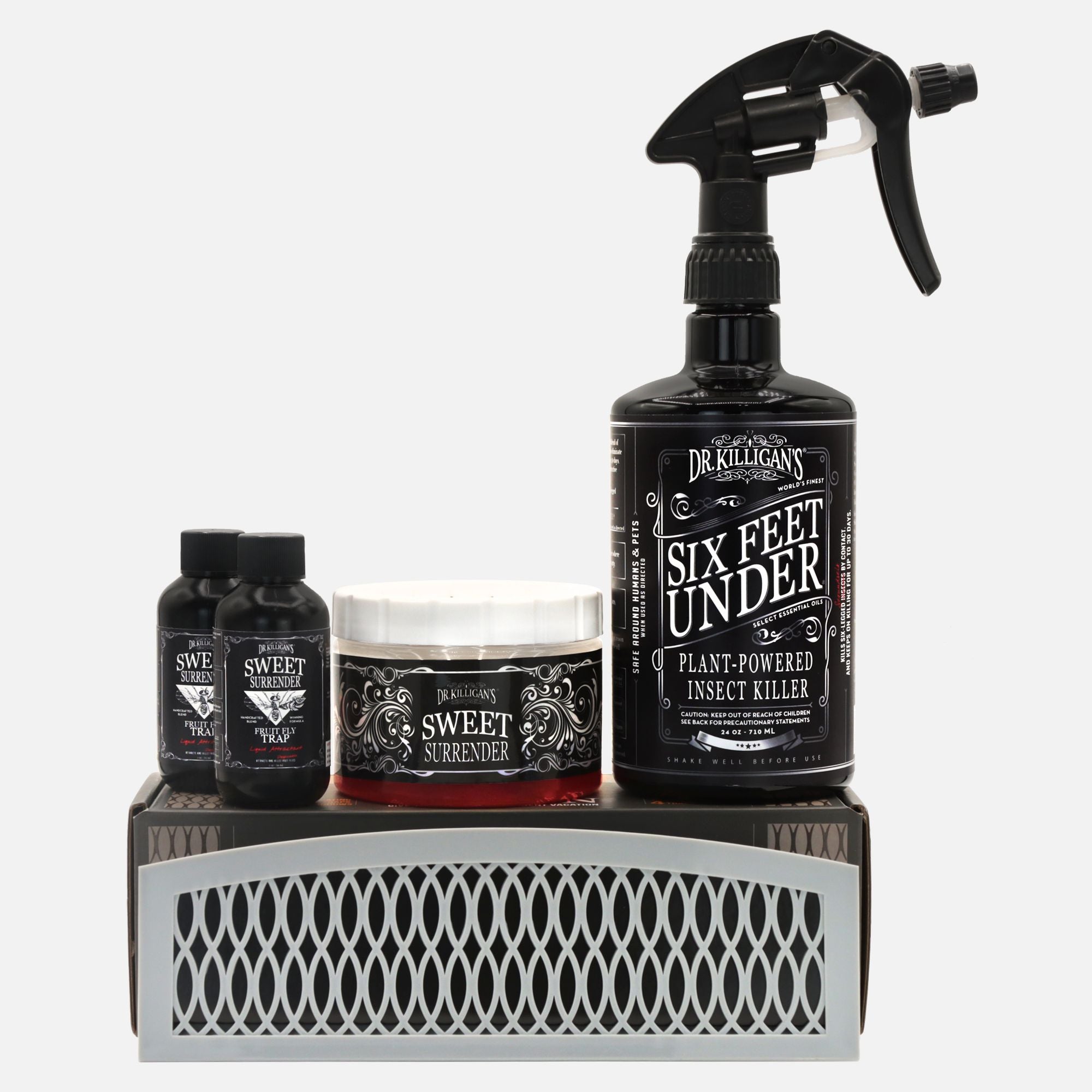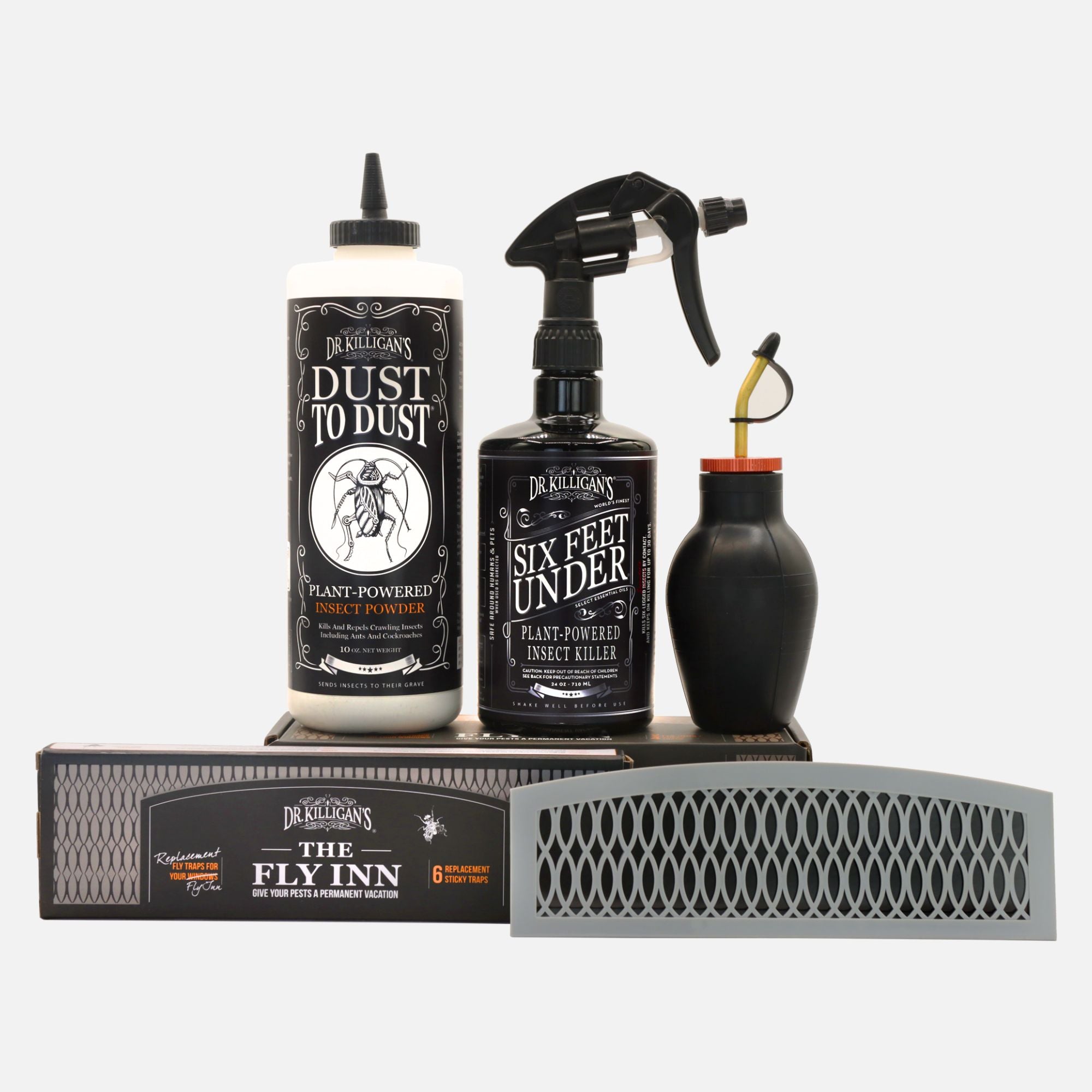Updated on July 19, 2024
Clothes moths are small, winged insects frequently seen in residences and other indoor settings. They are drawn to anything composed of natural fibers—like wool, silk, fur and feathers—which they consume and utilize to lay their eggs.
If left uncontrolled, clothes moths can seriously harm clothing, carpets and other home objects as their larvae feed on the fibers of these fabrics, leaving behind unattractive holes and damage.
There are two common species of clothes moth: webbing clothes moths (Tineola bisselliella) and case-bearing clothes moths (Tinea pellionella). While these two types of moths are very similar, webbing clothes moths are known as “the common clothes moth,” as they are more prevalent.
In this article, I’ll discuss how long clothes moths live by explaining their life cycle. Thus, if you find that you have clothes moths in your home, you’ll be well aware of how quickly (or not so quickly) they’re reproducing and how long it might take to rid your home of them.
What is a quick overview of a clothes moth’s life cycle?

Eggs are laid. On average, the female lays 40 to 50 eggs. These eggs mature quickly, usually within 4 to 10 days, and subsequently hatch within 10 to 21 days.
Damaging larvae hatch. These destructive larvae feast (and feast). Webbing clothes moths ferociously feed for 35 days or more, whereas case-bearing clothes moths fiercely feed for 68 to 87 days.
Resting pupae grow. Hidden locations are chosen. A silken cocoon, in which fibers from infested fabric and excrement are contained, becomes their new home for 8 to 40 days, depending on the season.
Adult moths emerge. They mate and reproduce, but do not feed or cause damage to materials. After depositing their eggs, the female moths die soon after, while the males continue to mate for another month, until their lives, too, come to an end.
Clothes moths go through complete metamorphosis—egg, larva, pupa, adult—each stage marking a significant turning point in their existence. As with many creatures, their total development time depends greatly on food availability, temperature and humidity. Generally, their lifespan is around two to three months long, though in some cases they can survive up to a year (or more).
The egg stage: Where do clothes moths lay eggs?
Clothes moths prefer to lay their soft, white eggs in quiet, undisturbed areas where the larvae will have immediate access to food upon hatching. Commonly, these eggs are deposited deep within the threads of natural fiber garments like cashmere sweaters, wool coats, leather jackets, silk scarves and other keratin-rich fabrics. The eggs are sticky, being fastened by a gelatinous, gluey material, which ensures they are not readily shaken off during routine movements of the infested items.
These pinhead-sized eggs are laid singly or in clusters hidden in seams, folds and less trafficked areas of closets and drawers. This strategic placement allows the eggs to remain undisturbed, enhancing the survival rate of the larvae.
In addition to clothing, these moths may also choose to lay eggs in a variety of other dark and undisturbed textiles around the home, including upholstered furniture, curtains, carpets and even decorative items that contain animal fibers.
Note: For a comprehensive list of all the materials that clothes moths target, read Do clothing moths actually eat clothes?
The larvae stage: How destructive are they?
The newly hatched larvae, white or cream colored with brown heads, look like wiggling pieces of rice. They are voracious feeders with an insatiable appetite, starting out at less than one-fifth inch long and growing to be as large as one-half inch. These greedy little feasters happily digest the fabrics they came into being on.
Note: If synthetic materials (or other non-keratin materials) are present and stained with food particles, soiled by bodily odors or blended with wool, these may also be eaten. Even sheepskin rugs, taxidermy animals and furniture are not safe.

The larvae of the webbing clothes moth have no eyes and, though they may create a feeding tube, this tube is not portable.
The tube: The tube (if present) is made up of the fibers they graze upon, silk and fecal particles. If there is no tube, the larvae spin silken patches as they giddily devour your favorite beige scarf.
On the other hand, the larvae of the case-bearing clothes moths have one simple eye on each side of their head and carry a silken case with them, like a memento of their childhood, wherever they go. The case will likely have dyes from the fabric on which the larva is feeding.
The case: The case enlarges as the moth grows and only the moth’s head and legs appear from outside of it, from either end of the case. Separation from case equals death. It really is a strong attachment.
Their level of destruction depends on what types of keratin-rich materials you have in the affected area and how you are storing said materials.
Evaluative questions to assess risk and damage:
- Material vulnerability: What types of materials are you storing? Are they delicate or high-quality natural fibers like cashmere or angora, which provide easy nourishment and suffer severe damage easily?
- Frequency of disturbance: How often are these fabrics moved or used? Items that are frequently used and moved are less likely to host a significant infestation compared to those that sit undisturbed for months or years.
- Light and airflow: Is your storage area dark and poorly ventilated? Such conditions are conducive to moth survival and reproduction, potentially increasing damage.
- Volume and type of stored items: How extensive is your collection of natural fibers? The more items you have, especially valuable or delicate ones, the greater the potential for significant damage.
Pocket Fact: Clothes moth larvae, according to this article by Learn About Nature, can consume around 2,700 times their body weight.
The pupae stage: How long does it take?
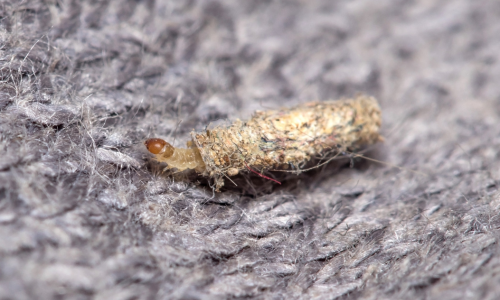
As noted above, the pupae stage can take anywhere from eight to 40 days. During this cocoon stage, specific cells in the moths’ bodies become active, ultimately disassembling the body into a mass of goo that is able to miraculously remodel itself.
This process, known as histolysis, is greatly impacted by seasons and environment, which is why this stage can be very short (just a mere eight days) in warmer seasons or climates or quite a bit longer in winter months or cooler climates.
It is during this stage that the larva is dormant, does not feed and transforms into an adult, its enclosure (in a cocoon) providing protection from predators and environmental factors. As it nears the end of this stage, it will begin to darken in color.
Tip: Larvae, in their cocoons, can be found in dark, undisturbed, protected locations. If you are able to locate such cocoons and disrupt this stage—through use of Six Feet Under Plant-Powered Insect Spray, vacuuming and cleaning—you can prevent an infestation from getting out of control.
The adult stage: Where are they hiding?
The adults have three methods of movement—flying, running and jumping—and one purpose. In terms of movement, they are weak fliers, fluttering about rather than flying in a direct steady pattern (as pantry moths do). The females prefer to walk or run; if clothes moths are seen fluttering about, they are most likely males. In terms of their purpose, it is to mate. The males use their antennae to detect minuscule amounts of pheromone in the air—that the females moths are dutifully releasing—and seek out said females. Giddily flying up into the pheromone cloud, they find their soon-to-be-mrs. and the mating occurs.

Size: Webbing clothes moths measure five to eight millimeters long—which is three quarters to three quarters and two pennies stacked on its side, whereas the case-bearing clothes moths measure at around seven millimeters—or two quarters and two nickels stacked on its side.
Looks: Webbing clothes moths are a uniform, yellowish-gold color, with a small tuft of reddish hairs on top of the head. They do not normally have spots. Case-bearing clothes moths are similar in appearance, but have dark spots (or specks) on the wings.
Behavior: Both species are shy, stealthy, good at hiding and often do undetected.
In your search for clothes moths—in egg, larva, pupa and adult stages—pay special attention to:
- Secluded areas: Explore the dark recesses of your walk-in closet, the backs of infrequently used dresser drawers and other less trafficked locations.
- Fabric preferences: Focus on areas where you store wool, fur, feathers, leather, silk and other keratin-rich fabrics.
- Hidden corners: Check in and around cuffs, collars and seams of garments, under furniture and in any textile folds where moths can conceal themselves.
- Rarely moved items: Moths tend to infest items that aren’t frequently moved or disturbed, like old costumes, seasonal wear or stored textiles.
Note: It’s extremely helpful to find out where these moths originated. Read Where do clothing moths come from for insight.
How do I get rid of these clothes eating moths?
With clothes moth issues on the rise and now that you’re fully aware of how quickly they’re reproducing, it’s high time to get rid of them.

I highly recommend our Clothing Moth Traps. These traps, which outperform all other clothes traps on the market, feature a proprietary, double-potent pheromone formula—a perfectly blended attractant and glue combination that the male moths simply can’t resist. They’ll awkwardly fly in (remember our conversation about how clothes moths can’t fly well?) and instead of finding the mrs., they’ll find their lives coming to an abrupt halt.
Place one on your clothing rod and one low to the ground in your closet and let our traps do the work for you.
For strategies and instructions on preventing infestations before they start, read 11 tips on how to prevent a clothing moth infestation. It’s packed with practical advice to help you maintain a moth-free home.
This, however, is just the beginning of the knowledge you need to fully get rid of clothes moths. For a comprehensive guide that includes six detailed steps, refer to How to get rid of clothing moths.


